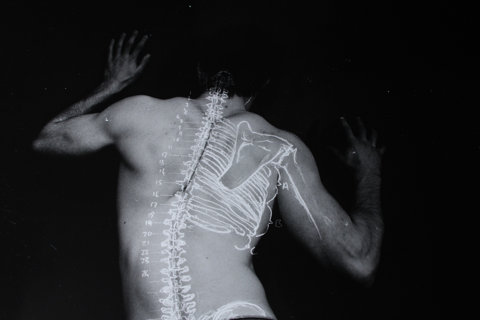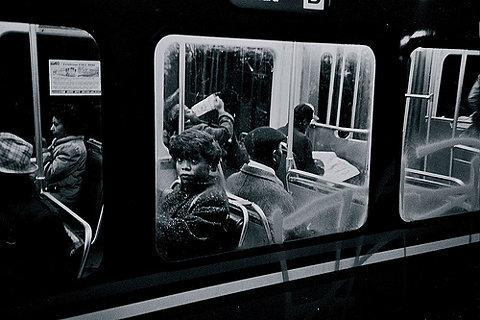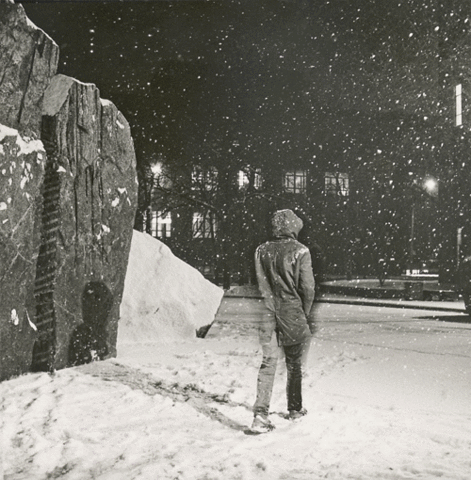Talk given at Gravity (at Downward Dog) in Toronto, August 12, 2014
Just sitting
For anyone here who has a sitting practice, or even if you’ve just tried it once or twice by yourself, to sit in meditation at home, by yourself, it can produce a range of feeling tones, it can hit all kinds of notes. But when we’re here, when we’re practicing together, some of those same sensations, or the history of your sitting, or the history of your paying attention that each of us brings with us into this room, it changes the flavor of the room.
Could you feel when you entered this room how busy it was? Even when everyone was sitting, there was a buzzing – it’s not good or bad – but there was a buzzing because we were carrying some of the outside in with us. We bring all of our moments of contact – contact between sense organ and sense object – we hold the memory of those contacts in this frame of a body, and then we bring them here, and out of that we create a room together.
What I’m describing is part of what Buddhists call causes and conditions. The Buddha said that nothing exists by itself, that every feeling that I have, and every feeling that you have, comes out of causes and conditions, an eco-system of events. Because we seem a little nomadic these days, wandering from one room to another, I’ve been wondering: how do we make a room together? What are some of the causes and conditions at work here?
Not Moving
When we decide, every person by themselves, but also all together as a group, we make this vow, we set this intention: to sit quietly, without moving, for thirty minutes. Why don’t we move in meditation? Because we’re trying to feel what this moment is like, the infinity of this moment, without needing to add anything to it. My sore knee, the itch in my nose, I’m celebrating everything that is happening in this moment by not intervening. It’s like being the United Nations of the self. I’m going to stay neutral, I’m not going to change a thing.
We just want to receive this moment as it is, without an extra groovy soundtrack, without something playing on the computer. If someone’s shouting on the street that’s ok, because that’s what is happening. It’s not just OK, it’s necessary. Nothing’s getting in my way, because whatever’s coming up is the way. And that includes my irritation, my impatience, my boredom, my sore back. Whatever is happening now in this moment.
Curiosity
We’re just trying to be here, aren’t we? – right here, without projecting our preferences. And as we sit together the whole room changes and it supports our intention to sit quietly. Could you feel that as we sat together? Can you feel that now? It’s so much easier, maybe it’s just me, but I find it so much easier to sit with others, than to sit by myself, because just like there’s a contagious energy in the buzz from outside, there’s also a contagious feeling of wanting to be awake. There’s a contagious feeling about curiousity. Hey, what’s happening now? Let’s investigate that irritation, where is it exactly in my body? Is it a gripping, a holding tight? Or is it a colour, or more like a song?
Slow Technology
Can we slow down enough to feel what is happening, right now? We are picking up this old technology, this technology of meditation, in order to change speeds.
And it’s curious that we’ve decided to do this together. We’ve come together to create a room, and the way this room feels, the taste of this room, the restlessness and hope of this room, is the result of every person here. If a single person left it would be different. When you get quiet in sitting practice, as we became quiet, I think it becomes easier to feel these shifts in the feeling tone of the room. In Buddhism they use a big word to describe this feeling, they call it interdependence, Thich Naht Hahn likes to call it inter-being, the way your feeling becomes my feeling, the way we are always becoming parts of each other, parts of the same room.
Rooms
I wanted to talk today about rooms. Could you imagine your life as a series of rooms? Your family might be a room. The person you’re in love with might be a very large room or a very small room – oh it used to be so roomy in here – or maybe it’s a room waiting for you to step into it. Your best friend might have a room all to herself. You might keep your secrets in a room, and your work in another.
Roles
In every room, in each of these rooms, there are a series of locations, there are different spots, different places, and each of those places has a different role. For instance, when I was in grade school, I always took the seat that was closest to the door. Just feeling the hallway that close to me was somehow reassuring. It offered me the always unrealized possibility of leaving, of an exit strategy. I think I could give a name to that place in the room, and the name is: commitment. Do I stay or do I go? There’s a place in every room you walk into that is about commitment. Do I belong here? Am I committed? Or do I have one foot in the door, and one foot in the hallway?
There are many rooms that are constructed for us, like the classroom for instance, and there are many rooms that we take part in constructing. Like the family. Or like this room for instance. How have you helped to create this room? With the way you smile. With the way you refuse to smile if you’re not feeling happy. Perhaps this is one of those rooms where you can just show up feeling the way you’re feeling, instead of putting on your game face. Alright I’m ready for those Zen people now, where are they?
Number One Son
There are so many places in a room. One of those places is about commitment. Another place in the room, in every room I walk into, there’s a place that’s reserved for what I like to call Number One Son. It might also be called Number One Daughter. This is the person who helps the parent, who is always dutiful and loyal, always wanting to pitch in, to make it OK. Even when the parent is wrong, number one daughter says: that’s OK. Even when the parent is hurting them number one son says: no problem dad, you’re the greatest. It is a place of unconditional love. It’s a place of deep acceptance, I accept you. I accept you even when you’re not at your best, even though I’ve seen you do the worst possible things I still accept you, that can be a very powerful force. Perhaps you’ve sat in that spot in the room, in one of your rooms.
Often rooms have certain roles that need to be fulfilled. In this room we mark time with a bell, and that means there’s a role for someone who is going to ring that bell. In other rooms, like the rooms of family for instance, there are different kinds of roles, the roles of mother and father for instance. Perhaps some of you are busy fulfilling those roles. It can be difficult, sometimes, when we step back into the rooms of our family, if our parents aren’t sitting in their usual places. My friend Laura told me recently that she goes with her father on trips out of town, or to go see musicals. Her father used to travel with his wife, but she died, so Laura has stepped into her place. I asked: did that turn you into your mother? Not at all, she assured me, in fact, she could be more herself, because her mother was intimidated by her, and as a result, Laura tried to keep herself small. Often in the family we like to use these special pills that allow us to change sizes, and the pill is called fear. Fear makes us smaller, it’s the exhale, while anger is the inhale that makes us larger, and they work together. Laura was always uncomfortable, even angry, in the room of her family, because the place where she was supposed to sit was too small for her.
Right Seeing
Sometimes, often in fact, you don’t get to choose the room you’re in. You don’t get to choose your biological family for instance, or the country you’re born into.
Sometimes it’s hard to raise your voice in the room because you just want to get along, you want to preserve some unspoken feeling of us-ness, of us all together. I also want to preserve this feeling, as if we were all thinking the same thoughts in the same way, but I would like to take a risk and speak through the word camouflage of corporate media.
Gaza
On July 8, 2014, Israel began Operation Protective Edge, a military campaign waged against nearly two million displaced Palestinians who are living under military occupation, many of them trying to return home. They are forced to live in Gaza, one of the most densely populated areas in the world and half its population are children (under the age of 16), so when the bombs began to fall, the deaths of hundreds of children and the injuries to more than two thousand children, many wounded in United Nations safe houses, came as no surprise. This is the from the longest standing Israeli reporter in the occupied territories, Amira Haas, writing for the Israeli newspaper Haaretz.
“In all the suffering and death,” wrote a friend from Gaza, “there are so many expressions of tenderness and kindness. People are taking care of one another, comforting one another. Especially children who are searching for the best way to support their parents. I saw many children no older than 10 years old who are hugging, comforting their younger siblings, trying to distract them from the horror. So young and already the caretakers of someone else. I did not meet a single child who did not lose someone – a parent, grandmother, friend, aunt or neighbor. And I thought: who will grow out of the generation that experienced the repeated massacres of the last seven years?”
When I think about the children of Gaza, helping their parents to grieve their losses, it makes me think about the front of the room. In nearly every room you step into, there’s someone or something at the front of the room. They’re the person that gets all the attention, they’re the object that might receives reverence or veneration, it’s the thing that absorbs time. And the front of the room is necessarily related to the back of the room, you know, where we put the not so smart, the not so beautiful, who me, I have nothing to say, I don’t know a thing.
Who do you like to put at the front of your room? The smartest person you know? The most powerful person you know? The person with the best yoga practice, that combines flexibility and strength? As Adam Phillips helpfully reminds us: we use our ideals to punish ourselves. I’ll never be that young. I’ll never be able to kick a soccer ball like that. I’ll never be that kind. I’ll never be that courageous. Over and over again, one of the primary ways that we defeat ourselves and we defeat our practice, is that we put something or someone perfect, oh they’re so perfect, at the front of the room, so that we can sit at the back of the room feeling crappy. And then we give that person all the attention, or all the authority.
Worst
Pema Chodron is an American Buddhist nun who studies in the Shambala tradition. When you read her words you can feel the years of deep practice. Here’s something from her excellent book When Things Fall Apart. “I get many letters from ‘the worst person in the world.’ (We might call this, the back of the room.) Sometimes this worst person is getting older and feels he has wasted his life. Sometimes she is a suicidal teenager reaching out for help. The people who give themselves such a hard time come in all ages, shapes, and colours. The thing they have in common is that they have no loving-kindness for themselves.”
Is there a place in the room, is there a place in your room for the worst person in the world? Or perhaps you reserve that place for someone else, for someone who has some of the qualities that you find it most difficult to stand in yourself? To be able to extend loving-kindness to yourself, I believe, it’s only my opinion, that this is the most important part of sitting meditation. It doesn’t matter if you can sit like a rock for a thousand hours during a snowstorm. What matters is that when you find that your mind has set off for another little wander you don’t have to take out your mental belt and hit yourself. Bad. Bad. What kind of meditation practice is that? Is your practice just another room where you can underline the fine art of self punishment? Is your practice another way to prove to yourself that you really are the worst person in the world?
I’ll never be a good meditator. I can’t concentrate on anything. I have a bad practice. You know why? Because I’m a bad person. How can we extend kindness to others, if we’re not able to feel it, to give it, to ourselves? How can we learn compassion, if we can’t deliver it to ourselves?
Which is not the same as being egotistical or self centered. The ego-driven distractions of the consumer machine are a kind of parody of loving kindness. All those I-machines, the social media come-ons, the lure of foreign vacations, they’re the sugar coating, the empty calories. It’s a quick fix because what you really need, from the toaster, or the new bicycle, or the new running shoes, is love, and because those objects are never going to love you, you’re going to have to keep buying them.
I keep thinking about those Palestinian children offering kindness to their brothers who just watched their sister die, to their fathers who just watched their mother die. They are practicing loving kindness even in the midst of a war (as you can hear, I’m putting them at the front of my room). I think one of the questions they are asking is: how do I create my rooms, the rooms I live in? The Buddha had a few words to say about this. The Buddha lived outdoors, you know, so he didn’t talk so much about rooms. He talked about trees, about ancient cities, and most of all about paths. In order to walk the path, in order to create your room, it requires what he called “right effort” or appropriate effort. Here’s the simplest definition I could find. Right effort or appropriate effort means developing wholesome qualities and releasing unwholesome qualities. Wholesome, it sounds like the breakfast cereal you didn’t want to have as a kid. But wholesome is about the whole, the whole room, it’s the kind of effort that you make, from the place you are sitting in the room, that nourishes every place in the room – from number one daughter, to the bell ringer, from the person sitting next to the door, to the person who is at the front of the room. It’s wholesome.
Appropriate effort develops wholesome qualities and releases unwholesome qualities. The Buddha felt that appropriate effort was central, absolutely central, to what he called the eightfold path, in fact right effort or appropriate effort, is fold number six of the eight folds. Sometimes when he talked about it, he broke it down further, and said that right effort is made up of what he called “the four great efforts.” What are the four great efforts? “To prevent from arising negative states that have not arisen. To let go of negative states once they have arisen. To give rise to positive states that have not yet arisen. To sustain positive states once they have arisen.”
Here is Martine Batchelor: “These efforts encourage the cultivation of positive patterns as a means to help overcome negative patterns. But although they are simple, they are by no means easy.
It’s not just a question of throwing away what’s negative and saying yes to what is positive. The Buddha suggests that over time, we consciously create the conditions that prevent negative thoughts and emotions from occurring in the first place, as well as the conditions that naturally enable positive thoughts and emotions to occur. (In other words, if you have a problem with drinking, the room you want to be in is probably not a bar.) The teachings of Buddhism emphasize how everything in life is the consequence of causes and conditions, and these four great efforts are meant to help us develop the causes and conditions for more peace, stability, joy, and openness… Much of Buddhist meditation consists of a systematic cultivation of positive patterns that enable us to engage creatively with those negative patterns that cause us pain.” (Let Go by Martine Batchelor)
Luxury
Peace, stability, joy and openness,… where do I sign? I think Martine is saying that you create a room, and in this room you try to create conditions that will prevent negative thoughts and emotions from occurring, and that cultivate positive thoughts and emotions. For some of you, for some of us, I think coming here is part of that. Isn’t it? To take some time, to live as if we had time again, time to feel what is actually happening in this moment. What a luxury of time is required for meditation, it’s as if we were children gain with nothing better to do except to feel this present moment. Which is something that children do so very well, better than a lot of meditators, often. To sit in a room with others who are also trying to feel this present moment, it creates good conditions in this room for sitting practice, for some kind of stability of mind, for some kind of peace of mind perhaps, for a certain openness to what is happening, and perhaps out of that openness, even an acceptance or peace. Peace, stability, joy, openness.
Positive Patterns
The cultivation of positive patterns. How do we do that? How do we cultivate positive patterns? I believe it is through the practice of loving kindness. I think it means offering yourself kindness, a soft touch, the softest touch of all, and when you can grant yourself that kindness, when you can let yourself off the hook, maybe you can look more honestly at the seat you are occupying, the place you’ve decided to put yourself, in the room. Maybe you need to sit close to the door, and that’s OK. Maybe you needed to sleep in, instead of coming to the sitting group. Maybe your thoughts wandered during sitting practice, can you let that be OK? Can you give those wandering thoughts a hug? How can we accept our broken, fearful selves, the selves that want to go to war?
Negative Patterns
If we can work on the cultivation of positive patterns through loving kindness, how might we try to deal with the cultivation of negative patterns? There are many different answers to this question, but I’d like to offer just one here. It might have something to do with what you like to put at the front of your room. Do you like to put perfect sentences, perfect yoga teachers, the most heavenly sounds at the front of your room? The reason they’re so big is because you’re so small, in fact, you can keep yourself small by making sure that they stay large. Oh perfect teacher of mine. Oh perfect book, perfect speaker, the one with all the answers. Over and over again the Buddha told the people around him: no one has the answers to your life. Be your own authority. I think this means that at some point, you have to be the one at the front of your own room, anything else is a borrowed shine, Oedipal traumas, parental hangovers.
There are moments in our lives when we are called to stand at the front of the room. Your best friend just broke up with their significant other, someone in your family is sick, you’re asked to run a workshop, or speak to a client. How do you appear when you sit at the front of the room? In the past half dozen years I’ve spent a lot of time being a student, and it’s given me an excellent opportunity to see who I like to put at the front of the room, and what people do there. The best teachers I’ve had are the ones who can make mistakes, and then point them out. Not only are they demonstrating how mindfulness works in real time, but if the person at the front of the room can model mistakes, can demonstrate how they are making mistakes, it gives me permission to make mistakes. It means that when I make mistakes, and I’m going to make them, I don’t have to pretend they don’t exist, or banish them from the room, or get super frustrated. It’s just part of what is going on here and now. In fact, the way we treat our mistakes, our bad behaviours, our mess making, is at the very heart of our practice. That is the place where loving kindness can enter. We model this place in sitting practice, when our mind wanders, and then we notice. Oh, our mind has wandered, and then we return to the object of meditation, the breath. This moment of recognition: Oh! is also the moment of self-care. Could we make that moment soft, like taking the hand of a child who has wandered off a path. The child doesn’t need to be shouted at or scolded, all you need to do is extend your hand and they take it, and now you’re back to the breath.
Privilege
The Buddha spoke so often about causes and conditions. I wanted to say just a few words about the front of the room, and some of the causes and conditions that are swirling around that precious place. As you might have noticed I’m a guy, a white guy, and white guys are always sitting at the front of the room. In the pope’s chair, the university dean, in the mayor’s office, the prime minister’s office, not just this year but last year, and the year before that, and the century before that. The whole culture has been designed so that people like me can sit right here at the front of the room. The whole culture reflects me, my gender, my race, culture has been custom-designed to give me a voice, and a variety of story options. It does this in libraries filled with books and in movie after movie. Everywhere I look my experience, or my potential experience, is being reflected.
These reflections are made at the expense of a lot of other people, the dominant culture is also a room, and it assigns places in that room for women, for people of colour, for people who celebrate different kinds of sexual preferences. There’s a name for this practice and the name is: privilege. And one of the ways that privilege works is that it should always be in disguise, it should always operate under cover, under camouflage. And as soon as you take the cover of privilege away and start to talk about it, it gives me a bad feeling, I can feel unwanted sensations, agitation. I think it’s very important to understand privilege in this way, when you can start to see it, you wake up. When you start to see the machine of gender, the machine of whiteness, it causes great discomfort or anger or shame, and these are the beginnings of awakening. I know I know awakening is supposed to happen by yourself on the mountain side, where you can’t keep this big shit-eating grin from spreading across your face. But the Buddha asked us to be in this world, to be part of this world, and to examine its causes and conditions. To wake up to this world as it is.
When I was asked me to give a talk I was very reluctant, though I didn’t know why. I have a lot of questions these days, and not much else. I wanted to chip in and help in some way. But there was something nagging at me, some uneasy sensations and that turned out to be the question of who gets to speak. I started wondering: is this a room that is designed, like so many other rooms in the culture, to stage the projections of white men? Or perhaps I could put it another way. When the Buddha speaks about the four great efforts as “efforts that encourage the cultivation of positive patterns as a means to help overcome negative patterns” couldn’t that mean that this room might be designed as a place where women could speak? Wouldn’t letting women sit at the front of the room, having women ring the bell or lead the chant, couldn’t we name those as “positive patterns?” I’m not saying men are bad and women are good, but we are not the first people to step into this room, people have been stepping into rooms like this for centuries – that’s part of our conditions and causes – and the person at the front of the room has usually been a man. For centuries there has been guy after guy. When the Buddha encouraged us to be a stream entrant, it means: moving against the stream of dominant opinion, particularly when it is unjust.
I wondered about the famous Buddhist ideology of holding both sides, oh yes but I can also see the other side, says the good Buddhist scholar, what does it mean “to see the other side” when the two sides are not equal. There’s one side that already receives all the attention, the stories, the money, the recognition, and then there’s the other side that is considered something lesser. I don’t know about you, but whenever I hear a Zen koan I can’t help thinking: what kind of world do these people live in, have they just wiped out all the women? What does it mean to hold both sides equally, when they’re not equal at all, isn’t that just another way of saying yes to the ruling class?
I’ve been wondering about what kind of room we are building here, what kind of room we are part of, and what right effort might look like here. In this moment, this present moment. Perhaps I could just put it to you as a question. What does right effort look like in your life, or what might right effort look like in this room?










